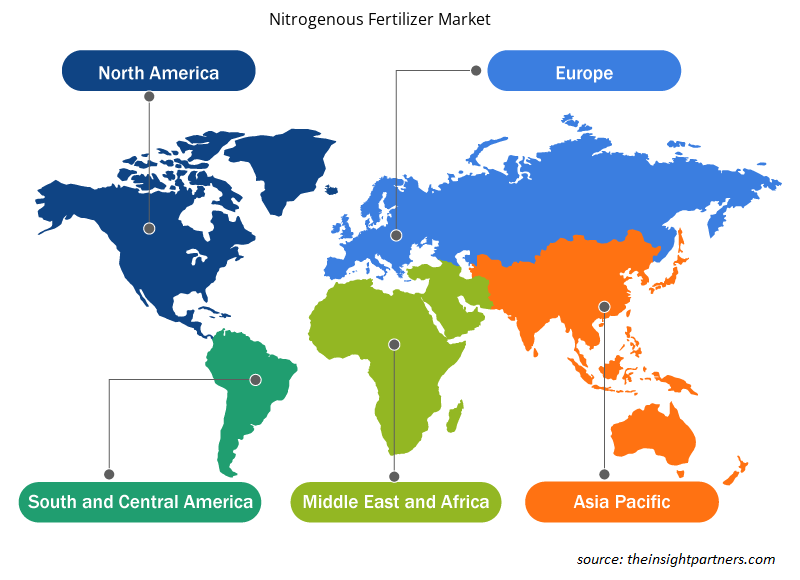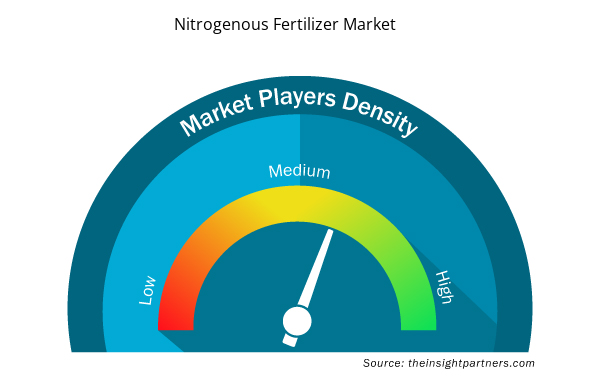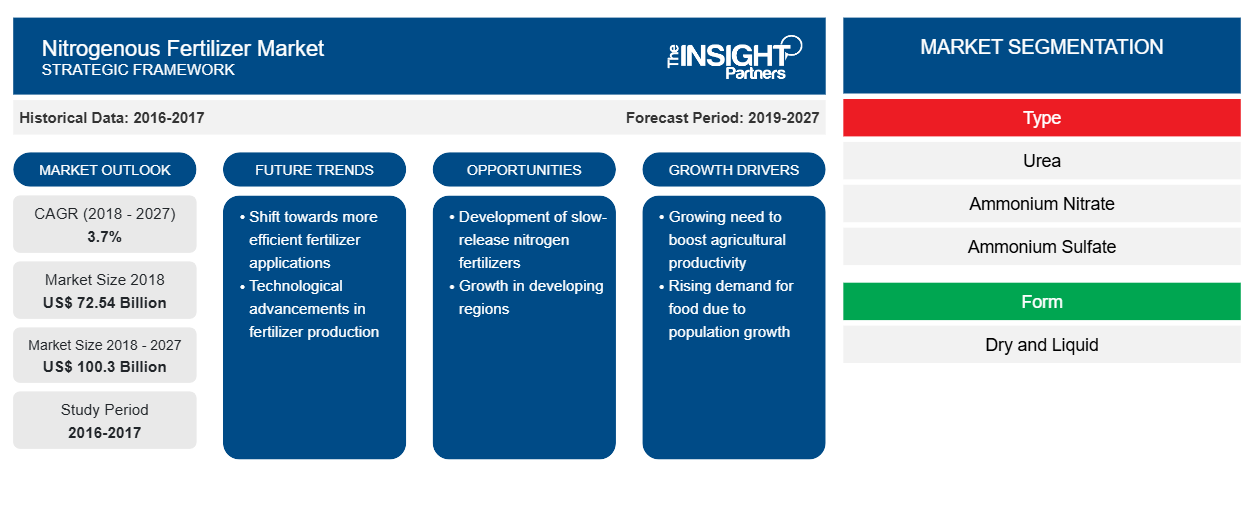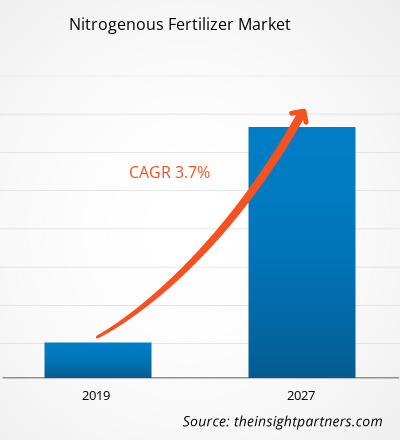بلغت قيمة سوق الأسمدة النيتروجينية 72,537.57 مليون دولار أمريكي في عام 2018 ومن المتوقع أن تنمو بمعدل نمو سنوي مركب قدره 3.7٪ من عام 2019 إلى عام 2027 لتصل إلى 100,304.42 مليون دولار أمريكي بحلول عام 2027.
يتم إنتاج الأسمدة النيتروجينية من خلال الاستفادة من النيتروجين من الهواء، ثم يتعرض لتفاعل كيميائي معقد. يستخدم النيتروجين لتعزيز نمو المحاصيل ويوفر ملمسًا ولونًا أفضل للنباتات، وبالتالي يساعد على تحسين الإنتاجية الزراعية. تعتبر عملية هابر بوش هي التقنية الأكثر تفضيلاً المستخدمة لإنتاج الأسمدة النيتروجينية Market . يعد الغاز الطبيعي أحد المواد الخام المهمة، والذي يستخدم في عملية هابر بوش جنبًا إلى جنب مع أشكال أخرى من المواد الخام مثل روث الحيوانات والسماد العضوي، من بين أمور أخرى. أدى الارتفاع في عدد السكان إلى زيادة الطلب على الأمن الغذائي، وبالتالي، يدفع الحاجة إلى استخدام مثل هذه الأسمدة لتوفير العناصر الغذائية الأساسية في التربة لتعزيز جودة التربة، مما يؤدي في النهاية إلى زيادة الغلة.
من المتوقع أن ينمو سوق الأسمدة النيتروجينية في أمريكا الشمالية بأعلى معدل نمو سنوي مركب خلال الفترة المتوقعة. تعد أمريكا الشمالية أسرع سوق نموًا للأسمدة النيتروجينية نظرًا لزيادة استخدام الأسمدة النيتروجينية المدعومة بتدابير حكومية إيجابية لدعم نمو الصناعة. علاوة على ذلك، من المرجح أيضًا أن يؤدي زيادة الدخل المتاح إلى جانب زيادة الاستثمار في المرافق الزراعية الأفضل إلى زيادة الطلب على الأسمدة النيتروجينية في سوق أمريكا الشمالية. ومع ذلك، أدت المخاطر البيئية والصحية الناجمة عن استخدام مثل هذه الأسمدة الاصطناعية إلى زيادة استخدام المنتجات الزراعية العضوية. وقد يعيق هذا نمو سوق الأسمدة النيتروجينية.
قم بتخصيص هذا التقرير ليناسب متطلباتك
ستحصل على تخصيص لأي تقرير - مجانًا - بما في ذلك أجزاء من هذا التقرير، أو تحليل على مستوى الدولة، وحزمة بيانات Excel، بالإضافة إلى الاستفادة من العروض والخصومات الرائعة للشركات الناشئة والجامعات
- احصل على أهم اتجاهات السوق الرئيسية لهذا التقرير.ستتضمن هذه العينة المجانية تحليلاً للبيانات، بدءًا من اتجاهات السوق وحتى التقديرات والتوقعات.
رؤى السوق
نمو الزراعة التجارية
تُعرَّف الزراعة التجارية في الأساس بأنها زراعة المحاصيل لبيع المنتجات لتحقيق الربح في السوق المحلية أو سوق التصدير. وقد قامت الزراعة التجارية بإصلاح وبدء تطور تدريجي في قطاع الزراعة. وقد أثر ارتفاع عدد السكان إلى جانب استخدام التكنولوجيا المحسنة والمرافق الأساسية الأفضل بشكل إيجابي على نمو الزراعة التجارية. وقد أرست التطورات في الصناعة الزراعية الأساس لتبني التكنولوجيا واستخدام الأسمدة عالية الجودة لتعزيز الغلة مثل الأسمدة القائمة على النيتروجين. وبالتالي، فإن نمو الزراعة التجارية من شأنه أن يستلزم زيادة الطلب على الأسمدة النيتروجينية. على سبيل المثال، اكتسب إدخال واستخدام اليوريا المغلفة إلى جانب زيادة الطلب على الأسمدة المخلوطة بالنيتروجين والفوسفور والبوتاسيوم وتبني الأسمدة المغلفة بالخميرة أهمية في الصناعة الزراعية لتحسين خصوبة التربة. في الوقت الحاضر، تستخدم غالبية العمليات الزراعية الآلات المتقدمة والتقنيات المتطورة. على سبيل المثال، أصبح استخدام أجهزة استشعار التربة والطائرات بدون طيار جزءًا أساسيًا من الزراعة واسعة النطاق، ومن المتوقع أن تحقق الزراعة الرأسية خطوات متعددة من خلال حصاد المحاصيل دون استخدام أشعة الشمس أو التربة.
رؤى المنتج
بناءً على التطبيق، يتم تقسيمه إلى اليوريا ونترات الأمونيوم وكبريتات الأمونيوم والأمونيا ونترات أمونيوم الكالسيوم وغيرها. شكلت شريحة اليوريا أكبر حصة من السوق العالمية في عام 2018، في حين من المتوقع أن ينمو سوق كبريتات الأمونيوم بأعلى معدل نمو سنوي مركب خلال فترة التنبؤ. أحد أول مصادر النيتروجين الصلبة المصنعة على نطاق واسع هو نترات الأمونيوم. سماد نترات الأمونيوم له طبيعة متقلبة للغاية، مما يجعله مفيدًا في صناعات محددة. نترات الأمونيوم عبارة عن ملح بلوري عديم اللون تقريبًا وعديم الرائحة. يؤدي استخدام نترات الأمونيوم في الحدائق والحقول الزراعية واسعة النطاق إلى تحسين نمو النباتات ويوفر إمدادًا من النيتروجين يمكن للنباتات أن تستمد منه. سماد نترات الأمونيوم مركب بسيط الإنتاج. يتم إنتاجه عندما يتفاعل غاز الأمونيا مع حمض النيتريك. يشكل التفاعل الكيميائي صيغة مركزة من نترات الأمونيوم، والتي تنتج كميات هائلة من الحرارة. كسماد، يتم تلطيخ المركب على شكل حبيبات، ويتم دمجه مع كبريتات الأمونيوم لتقليل الطبيعة المتطايرة للمركب.
رؤى التطبيق
بناءً على نوع المحصول، يتم تقسيمه إلى الحبوب والبذور الزيتية والبقول والفواكه والخضروات وغيرها. شكلت شريحة الحبوب والحبوب أكبر حصة من السوق في عام 2018، في حين من المتوقع أن تسجل شريحة البذور الزيتية والبقول أعلى معدل نمو سنوي مركب خلال فترة التوقعات. تتطلب جميع محاصيل البذور الزيتية والبقول النيتروجين بكميات كبيرة إلى حد ما. النيتروجين هو العنصر الغذائي الأكثر تقييدًا في إنتاج البذور الزيتية والبقول في جميع أنحاء العالم. تأخذ المحاصيل عادةً معظم النيتروجين من التربة في شكل نيتروجين نترات. عندما تكون مستويات النيتروجين في التربة كافية، يعزز النيتروجين النمو الديناميكي ومساحة أوراق أكبر بلون أخضر داكن. تحليل التربة مفيد جدًا في تقدير متطلبات الأسمدة النيتروجينية. كان الطلب المتزايد على الزيوت والبقول في جميع أنحاء العالم أحد العوامل الرئيسية المساهمة في توسيع نطاق الأسمدة النيتروجينية. أدى الميل المتزايد للناس نحو نمط حياة صحي إلى زيادة استهلاك البذور الزيتية والبقول، نظرًا لفوائدها الصحية. وقد أدت كل هذه العوامل إلى تعزيز الطلب على سوق الأسمدة النيتروجينية، كما ساهمت في توسع السوق في جميع أنحاء العالم.
من بين الشركات القليلة العاملة في سوق الأسمدة النيتروجينية شركة Bunge Limited، وشركة CF Industries Holdings, Inc.، وشركة EuroChem Group، وشركة Koch Fertilizer, Llc، وشركة Nutrien Ltd.، وشركة OCI Nitrogen. وتنفذ الشركات الرئيسية عمليات الدمج والاستحواذ، واستراتيجيات البحث والتطوير لتوسيع قاعدة العملاء والحصول على حصة كبيرة في السوق العالمية، وهو ما يسمح لها أيضًا بالحفاظ على اسم علامتها التجارية عالميًا.
تقرير يسلط الضوء على
- اتجاهات الصناعة التقدمية في سوق الأسمدة النيتروجينية لمساعدة اللاعبين على تطوير استراتيجيات فعالة طويلة الأجل
- استراتيجيات نمو الأعمال التي تتبناها الأسواق المتقدمة والنامية
- التحليل الكمي لسوق الأسمدة النيتروجينية من 2019 إلى 2027
- تقدير الطلب العالمي على الأسمدة النيتروجينية
- تحليل PEST لتوضيح فعالية المشترين والموردين العاملين في الصناعة
- التطورات الأخيرة لفهم سيناريو السوق التنافسي
- اتجاهات السوق وتوقعاتها بالإضافة إلى العوامل التي تدفع وتكبح نمو سوق الأسمدة النيتروجينية
- المساعدة في عملية اتخاذ القرار من خلال تسليط الضوء على استراتيجيات السوق التي تدعم المصلحة التجارية، مما يؤدي إلى نمو السوق
- حجم سوق الأسمدة النيتروجينية في مختلف العقد
- نظرة عامة مفصلة وتقسيم السوق، بالإضافة إلى ديناميكيات صناعة الأسمدة النيتروجينية
- حجم سوق الأسمدة النيتروجينية في مختلف المناطق مع فرص نمو واعدة
رؤى إقليمية حول سوق الأسمدة النيتروجينية
لقد قام المحللون في Insight Partners بشرح الاتجاهات والعوامل الإقليمية المؤثرة على سوق الأسمدة النيتروجينية طوال فترة التوقعات بشكل شامل. يناقش هذا القسم أيضًا قطاعات سوق الأسمدة النيتروجينية والجغرافيا في جميع أنحاء أمريكا الشمالية وأوروبا ومنطقة آسيا والمحيط الهادئ والشرق الأوسط وأفريقيا وأمريكا الجنوبية والوسطى.

- احصل على البيانات الإقليمية المحددة لسوق الأسمدة النيتروجينية
نطاق تقرير سوق الأسمدة النيتروجينية
| سمة التقرير | تفاصيل |
|---|---|
| حجم السوق في عام 2018 | 72.54 مليار دولار أمريكي |
| حجم السوق بحلول عام 2027 | 100.3 مليار دولار أمريكي |
| معدل النمو السنوي المركب العالمي (2018 - 2027) | 3.7% |
| البيانات التاريخية | 2016-2017 |
| فترة التنبؤ | 2019-2027 |
| القطاعات المغطاة | حسب النوع
|
| المناطق والدول المغطاة | أمريكا الشمالية
|
| قادة السوق وملفات تعريف الشركات الرئيسية |
|
كثافة اللاعبين في السوق: فهم تأثيرها على ديناميكيات الأعمال
يشهد سوق الأسمدة النيتروجينية نموًا سريعًا، مدفوعًا بالطلب المتزايد من المستخدم النهائي بسبب عوامل مثل تفضيلات المستهلكين المتطورة والتقدم التكنولوجي والوعي المتزايد بفوائد المنتج. ومع ارتفاع الطلب، تعمل الشركات على توسيع عروضها والابتكار لتلبية احتياجات المستهلكين والاستفادة من الاتجاهات الناشئة، مما يؤدي إلى زيادة نمو السوق.
تشير كثافة اللاعبين في السوق إلى توزيع الشركات أو المؤسسات العاملة في سوق أو صناعة معينة. وهي تشير إلى عدد المنافسين (اللاعبين في السوق) الموجودين في مساحة سوق معينة نسبة إلى حجمها أو قيمتها السوقية الإجمالية.
الشركات الرئيسية العاملة في سوق الأسمدة النيتروجينية هي:
- بانج المحدودة
- شركة سي اف للصناعات القابضة المحدودة
- مجموعة يوروكيم
- شركة كوش للأسمدة المحدودة
- شركة نيوترين المحدودة
إخلاء المسؤولية : الشركات المذكورة أعلاه ليست مرتبة بأي ترتيب معين.

- احصل على نظرة عامة على أهم اللاعبين الرئيسيين في سوق الأسمدة النيتروجينية
سوق الأسمدة النيتروجينية حسب النوع
- اليوريا
- نترات الامونيوم
- كبريتات الامونيوم
- الأمونيا
- نترات الكالسيوم والأمونيوم
- آحرون
سوق الأسمدة النيتروجينية – حسب الشكل
- جاف
- سائل
سوق الأسمدة النيتروجينية – حسب نوع المحصول
- الحبوب والحبوب
- البذور الزيتية والبقوليات
- الفواكه والخضروات
- آحرون
نبذة عن الشركة
- بانج المحدودة
- شركة سي اف للصناعات القابضة المحدودة
- مجموعة يوروكيم
- شركة كوش للأسمدة المحدودة
- شركة نيوترين المحدودة
- نيتروجين OCI
- مجموعة سابك
- سينوفيرت
- توجلياتيازوت (تواز)
- شركة يارا الدولية
- التحليل التاريخي (سنتان)، السنة الأساسية، التوقعات (7 سنوات) مع معدل النمو السنوي المركب
- تحليل PEST و SWOT
- حجم السوق والقيمة / الحجم - عالميًا وإقليميًا وقطريًا
- الصناعة والمنافسة
- مجموعة بيانات Excel


- Artificial Turf Market
- Advanced Planning and Scheduling Software Market
- Dried Blueberry Market
- Virtual Event Software Market
- Fertilizer Additives Market
- Photo Editing Software Market
- Integrated Platform Management System Market
- Wire Harness Market
- Water Pipeline Leak Detection System Market
- Fish Protein Hydrolysate Market

Report Coverage
Revenue forecast, Company Analysis, Industry landscape, Growth factors, and Trends

Segment Covered
This text is related
to segments covered.

Regional Scope
North America, Europe, Asia Pacific, Middle East & Africa, South & Central America

Country Scope
This text is related
to country scope.
الأسئلة الشائعة
Among all six segments of product type, the ammonium sulfate is the fastest growing segment in the nitrogenous fertilizer market. Ammonium Sulfate is a chemical compound that is crystalline in nature primarily used to manufacture artificial alkaline soil fertilizers for agriculture. Ammonium Sulfate is inorganic and is a water-soluble salt containing 21% Nitrogen and 24% Sulfur. Ammonium sulfate's high nitrogen content makes it the perfect supplement for nitrogen deficient soils and lands. As lawn grass requires nitrogen, commercial lawn fertilizer products apply ammonium sulfate to stimulate quick growth of grass turf and healthy lawn grass. Ammonium sulfate fertilizers can easily blend with other nitrogen fertilizers allowing for a more stable, dry-lawn fertilizer.
The major players operating in the global nitrogenous fertilizer market are Bunge Limited, CF Industries Holdings, Inc., EuroChem Group, Koch Fertilizer, LLC, Nutrien Ltd, OCI Nitrogen, SABIC Group, Sinofert, Togliattiazot (TOAZ) and Yara International ASA among many others.
In 2018, the nitrogenous fertilizer market was predominant by Asia Pacific at the global level. The largest market share of the Asia Pacific region is primarily attributed to the rise in population and increase in demand for food. Further, the presence of large agricultural lands along with integration of advanced technology with the use of mineral fertilizers such as nitrogen based fertilizers is propelling the demand for nitrogenous fertilizer in this region. Moreover, the growing focus towards commercial farming is also expected to boost the demand for nitrogenous fertilizers in the region. The Asia Pacific market is characterized by the strong presence of players such as SABIC Group, Sinofert, Togliattiazot. and OCI Nitrogen among others.
The List of Companies - Global Nitrogenous Fertilizer Market
- Bunge Limited
- CF Industries Holdings, Inc.
- EuroChem Group
- Koch Fertilizer, Llc
- Nutrien Ltd.
- OCI Nitrogen
- SABIC Group
- Sinofert
- TOGLIATTIAZOT (TOAZ)
- Yara International ASA
The Insight Partners performs research in 4 major stages: Data Collection & Secondary Research, Primary Research, Data Analysis and Data Triangulation & Final Review.
- Data Collection and Secondary Research:
As a market research and consulting firm operating from a decade, we have published and advised several client across the globe. First step for any study will start with an assessment of currently available data and insights from existing reports. Further, historical and current market information is collected from Investor Presentations, Annual Reports, SEC Filings, etc., and other information related to company’s performance and market positioning are gathered from Paid Databases (Factiva, Hoovers, and Reuters) and various other publications available in public domain.
Several associations trade associates, technical forums, institutes, societies and organization are accessed to gain technical as well as market related insights through their publications such as research papers, blogs and press releases related to the studies are referred to get cues about the market. Further, white papers, journals, magazines, and other news articles published in last 3 years are scrutinized and analyzed to understand the current market trends.
- Primary Research:
The primarily interview analysis comprise of data obtained from industry participants interview and answers to survey questions gathered by in-house primary team.
For primary research, interviews are conducted with industry experts/CEOs/Marketing Managers/VPs/Subject Matter Experts from both demand and supply side to get a 360-degree view of the market. The primary team conducts several interviews based on the complexity of the markets to understand the various market trends and dynamics which makes research more credible and precise.
A typical research interview fulfils the following functions:
- Provides first-hand information on the market size, market trends, growth trends, competitive landscape, and outlook
- Validates and strengthens in-house secondary research findings
- Develops the analysis team’s expertise and market understanding
Primary research involves email interactions and telephone interviews for each market, category, segment, and sub-segment across geographies. The participants who typically take part in such a process include, but are not limited to:
- Industry participants: VPs, business development managers, market intelligence managers and national sales managers
- Outside experts: Valuation experts, research analysts and key opinion leaders specializing in the electronics and semiconductor industry.
Below is the breakup of our primary respondents by company, designation, and region:

Once we receive the confirmation from primary research sources or primary respondents, we finalize the base year market estimation and forecast the data as per the macroeconomic and microeconomic factors assessed during data collection.
- Data Analysis:
Once data is validated through both secondary as well as primary respondents, we finalize the market estimations by hypothesis formulation and factor analysis at regional and country level.
- Macro-Economic Factor Analysis:
We analyse macroeconomic indicators such the gross domestic product (GDP), increase in the demand for goods and services across industries, technological advancement, regional economic growth, governmental policies, the influence of COVID-19, PEST analysis, and other aspects. This analysis aids in setting benchmarks for various nations/regions and approximating market splits. Additionally, the general trend of the aforementioned components aid in determining the market's development possibilities.
- Country Level Data:
Various factors that are especially aligned to the country are taken into account to determine the market size for a certain area and country, including the presence of vendors, such as headquarters and offices, the country's GDP, demand patterns, and industry growth. To comprehend the market dynamics for the nation, a number of growth variables, inhibitors, application areas, and current market trends are researched. The aforementioned elements aid in determining the country's overall market's growth potential.
- Company Profile:
The “Table of Contents” is formulated by listing and analyzing more than 25 - 30 companies operating in the market ecosystem across geographies. However, we profile only 10 companies as a standard practice in our syndicate reports. These 10 companies comprise leading, emerging, and regional players. Nonetheless, our analysis is not restricted to the 10 listed companies, we also analyze other companies present in the market to develop a holistic view and understand the prevailing trends. The “Company Profiles” section in the report covers key facts, business description, products & services, financial information, SWOT analysis, and key developments. The financial information presented is extracted from the annual reports and official documents of the publicly listed companies. Upon collecting the information for the sections of respective companies, we verify them via various primary sources and then compile the data in respective company profiles. The company level information helps us in deriving the base number as well as in forecasting the market size.
- Developing Base Number:
Aggregation of sales statistics (2020-2022) and macro-economic factor, and other secondary and primary research insights are utilized to arrive at base number and related market shares for 2022. The data gaps are identified in this step and relevant market data is analyzed, collected from paid primary interviews or databases. On finalizing the base year market size, forecasts are developed on the basis of macro-economic, industry and market growth factors and company level analysis.
- Data Triangulation and Final Review:
The market findings and base year market size calculations are validated from supply as well as demand side. Demand side validations are based on macro-economic factor analysis and benchmarks for respective regions and countries. In case of supply side validations, revenues of major companies are estimated (in case not available) based on industry benchmark, approximate number of employees, product portfolio, and primary interviews revenues are gathered. Further revenue from target product/service segment is assessed to avoid overshooting of market statistics. In case of heavy deviations between supply and demand side values, all thes steps are repeated to achieve synchronization.
We follow an iterative model, wherein we share our research findings with Subject Matter Experts (SME’s) and Key Opinion Leaders (KOLs) until consensus view of the market is not formulated – this model negates any drastic deviation in the opinions of experts. Only validated and universally acceptable research findings are quoted in our reports.
We have important check points that we use to validate our research findings – which we call – data triangulation, where we validate the information, we generate from secondary sources with primary interviews and then we re-validate with our internal data bases and Subject matter experts. This comprehensive model enables us to deliver high quality, reliable data in shortest possible time.


 احصل على عينة مجانية لهذا التقرير
احصل على عينة مجانية لهذا التقرير